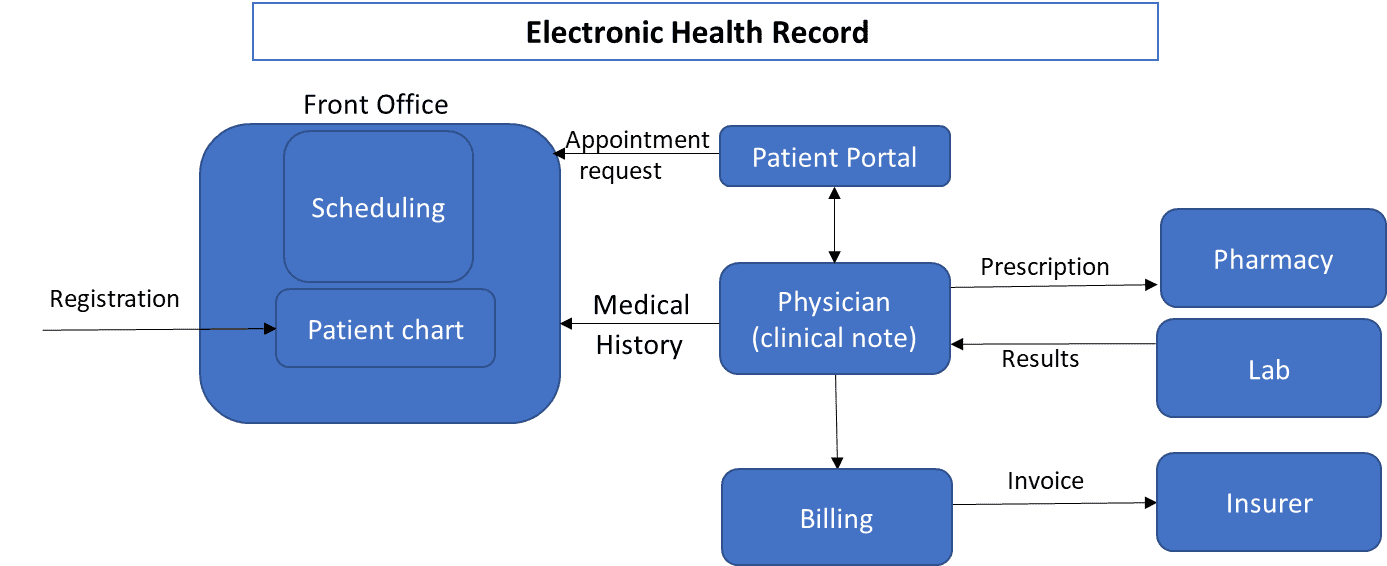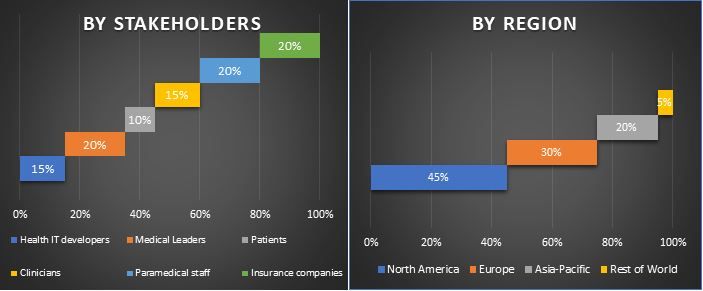- Startseite
- Über uns
- Industrie
- Dienstleistungen
- Lesen
- Kontaktieren Sie uns
Markt für elektronische Patientenakten: Aktuelle Analyse und Prognose (2021-2027)
Schwerpunkt auf Produkt (webbasiert, On-Premises-basiert); Typ (Akut, Ambulant, Post-Akut); Anwendungen (Klinisch, Administrativ, Reporting in Gesundheitssystemen, Gesundheitswesenfinanzierung und klinische Forschung); Endbenutzer (Krankenhäuser, Ambulante Versorgung, Apotheken, Sonstige) und Region & Land.

In der heutigen Zeit sind elektronische Patientenakten (EHRs) zu einem wichtigen Bestandteil medizinischer Praktiken geworden. Die Umstellung vom papierbasierten System auf das digitale System verbessert nicht nur die Arbeitsqualität, sondern auch die Erfahrung der Patienten. Für die effektive Erfassung und Weitergabe von Patientendaten benötigen Gesundheitsdienstleister eine elektronische Patientenakte (EHR) zur Speicherung von Daten in einem strukturierten Format. Strukturierte Daten helfen den Gesundheitsdienstleistern bei der einfachen Übertragung und dem einfachen Abruf von Patienteninformationen. Die Centers for Medicare & Medicaid Services und das Office of the National Coordinator for Health Information Technology (ONC) haben die Standardkriterien für strukturierte Daten zur Förderung von Interoperabilitätsprogrammen im Gesundheitswesen bestätigt.Die Nachfrage nach elektronischen Patientenakten steigt aufgrund der Zunahme der Nutzung von Informationstechnologie im Gesundheitswesen (HCIT), der hohen Akzeptanzrate von EHRs, der Zunahme der Anzahl chronischer Krankheiten und der Regierungsinitiativen zur Förderung des Einsatzes von IT im Gesundheitswesen. Darüber hinaus fördern der Anstieg der Gesundheitsausgaben und die Einführung von künstlicher Intelligenz (KI) in der Gesundheitsbranche das Marktwachstum. Beispielsweise hat PathAI mit Arzneimittelentwicklern wie Bristol-Myers Squibb und Organisationen wie der Bill & Melinda Gates Foundation zusammengearbeitet, um seine KI-Technologie in andere Teilbereiche des Gesundheitswesens auszuweiten.
Wertschöpfungskette des globalen Marktes für elektronische Patientenakten

Im Bericht dargestellte Erkenntnisse
„Unter den Produkten hält das webbasierte Segment den größten Anteil im Jahr 2020.“
Basierend auf den Produkten ist der globale Markt für elektronische Patientenakten in webbasiert und vor Ort basiert unterteilt. Das webbasierte Segment hält den größten Anteil, was auf die hohe Akzeptanz von webbasierten EHRs zwischen Gesundheitsdienstleistern und Ärzten zurückzuführen ist. Darüber hinaus kann eine EHR ohne die Notwendigkeit von internen Servern eingerichtet werden. SimplePractice ist eine webbasierte Lösung für psychische Gesundheit, die Gesundheitsdienstleistern hilft, Kundenbeziehungen durch Terminplanung, Zahlungsabwicklung und Dokumentation zu verwalten.
„Unter den Typen wird erwartet, dass das Segment Ambulant während des analysierten Zeitraums die höchste CAGR aufweist.“
Basierend auf den Typen ist der globale Markt für elektronische Patientenakten in Akut, Ambulant und Postakut unterteilt. Es wird erwartet, dass die ambulanten EHRs im Prognosezeitraum ein deutliches Wachstum zeigen werden. Die ambulante EHR wird hauptsächlich in Arztpraxen und ambulanten Einrichtungen eingesetzt. Ambulante EHRs helfen den Gesundheitsdienstleistern, die Krankengeschichte sowie die Behandlung des Patienten einfach zu verfolgen. Da die ambulante Behandlung für viele Patienten die gewünschte Option ist, hat die Verwendung von ambulanten EHRs in den letzten Jahren deutlich zugenommen.
„Die elektronische Patientenakte wird hauptsächlich für klinische Anwendungen verwendet.“
Basierend auf den Anwendungen ist der globale Markt für elektronische Patientenakten in Klinische Anwendungen, administrative Anwendungen, Berichterstattung in Gesundheitssystemen, Gesundheitsfinanzierung und klinische Forschung unterteilt. Es wird erwartet, dass das Segment der klinischen Anwendungen den Markt im Prognosezeitraum aufgrund der Zunahme der Anzahl chronischer Krankheiten und Operationen dominieren wird. Gemäß Burden of Obstructive Lung Disease (BOLD) beträgt die globale Prävalenz der chronisch-obstruktiven Lungenerkrankung (COPD) 10,1 %.
„Unter den Endverbrauchern führen Krankenhäuser die Einführung der elektronischen Patientenaktentechnologie an.“
Basierend auf dem Endverbraucher ist der globale Markt für elektronische Patientenakten in Krankenhäuser, ambulante Versorgung, Apotheken und andere unterteilt. Im Jahr 2020 haben Krankenhäuser den größten Markt für elektronische Patientenaktentechnologie, was auf die zunehmende Einführung von EHRs in Krankenhäusern zur Pflege großer klinischer Daten zurückzuführen ist. Der Health Information Technology for Economic and Clinical Health (HITECH) Act von 2009 unterstützte die Einführung und Verwendung von elektronischen Patientenakten (EHRs). Ab 2017 nutzten 94 % der Krankenhäuser ihre EHR-Daten, um Krankenhausprozesse durchzuführen, die die klinische Praxis informieren.
„Nordamerika hält im Jahr 2020 den größten Marktanteil am globalen Markt für elektronische Patientenakten.“
Für ein besseres Verständnis der Marktakzeptanz der elektronischen Patientenakte wird der Markt in wichtigen Regionen analysiert, darunter Nordamerika (Vereinigte Staaten, Kanada und das übrige Nordamerika), Europa (Deutschland, Frankreich, Italien, Spanien, Vereinigtes Königreich und übriges Europa), Asien-Pazifik (China, Japan, Indien, Australien und übriges APAC) und das übrige Welt. Nordamerika dominiert den Markt für elektronische Patientenakten aufgrund der hochentwickelten Gesundheitsinfrastruktur, der Gesundheitsausgaben und der Präsenz zahlreicher prominenter Akteure in den USA.
Wettbewerbsszenario
Zu den wichtigsten Akteuren auf dem Markt gehören GE Healthcare, Allscripts Healthcare Solutions, Cerner Corporation, Advanced Data Systems Corporation, Athenahealth, Inc., Advanced MD, eClinicalWorks, Epic Systems Corporation, McKesson Corporation und CPSI. Mehrere M&As sowie Partnerschaften wurden von diesen Akteuren eingegangen, um ihre Präsenz in verschiedenen Regionen zu stärken.
Gründe für den Kauf dieses Berichts:
- Die Studie umfasst eine Marktdimensionierungs- und Prognoseanalyse, die von authentifizierten wichtigen Branchenexperten validiert wurde
- Der Bericht bietet einen schnellen Überblick über die Gesamtleistung der Branche auf einen Blick
- Der Bericht umfasst eine detaillierte Analyse prominenter Branchenkollegen mit einem primären Fokus auf wichtige Finanzkennzahlen, Produktportfolio, Expansionsstrategien und aktuelle Entwicklungen
- Detaillierte Untersuchung von Treibern, Einschränkungen, wichtigen Trends und Chancen in der Branche
- Die Studie deckt den Markt umfassend über verschiedene Segmente hinweg ab
- Tiefgehende regionale Analyse der Branche
Anpassungsoptionen:
Der Markt für elektronische Patientenakten kann je nach Anforderung oder anderem Marktsegment weiter angepasst werden. Darüber hinaus versteht UMI, dass Sie möglicherweise Ihre eigenen geschäftlichen Anforderungen haben. Zögern Sie daher nicht, sich mit uns in Verbindung zu setzen, um einen Bericht zu erhalten, der vollständig Ihren Anforderungen entspricht.
Inhaltsverzeichnis
Die Analyse des historischen Marktes, die Schätzung des aktuellen Marktes und die Prognose des zukünftigen Marktes für die globale elektronische Patientenakte waren die drei Hauptschritte, die unternommen wurden, um die Einführung der Technologie in den wichtigsten Regionen weltweit zu erstellen und zu analysieren. Es wurden umfassende Sekundärrecherchen durchgeführt, um die historischen Marktzahlen zu sammeln und die aktuelle Marktgröße zu schätzen. Zweitens wurden zahlreiche Erkenntnisse und Annahmen berücksichtigt, um diese Erkenntnisse zu validieren. Darüber hinaus wurden ausführliche Primärinterviews mit Branchenexperten entlang der Wertschöpfungskette des Marktes für elektronische Patientenakten geführt. Nach der Annahme und Validierung der Marktzahlen durch Primärinterviews wendeten wir einen Bottom-up-Ansatz an, um die vollständige Marktgröße zu prognostizieren. Danach wurden Marktaufschlüsselungs- und Datentriangulationsmethoden angewendet, um die Marktgröße von Segmenten und Untersegmenten, die die Branche betreffen, zu schätzen und zu analysieren. Die detaillierte Methodik wird im Folgenden erläutert:
Analyse der historischen Marktgröße
Schritt 1: Eingehende Untersuchung von Sekundärquellen:
Es wurde eine detaillierte Sekundärstudie durchgeführt, um die historische Marktgröße des globalen Marktes für elektronische Patientenakten aus unternehmensinternen Quellen wie Geschäftsberichten & Finanzberichten, Performance-Präsentationen, Pressemitteilungen usw. und externen Quellen wie Fachzeitschriften, Nachrichten & Artikeln, Regierungsveröffentlichungen, Wettbewerberpublikationen, Branchenberichten, Datenbanken von Drittanbietern und anderen glaubwürdigen Publikationen zu erhalten.
Schritt 2: Marktsegmentierung:
Nachdem wir die historische Marktgröße erhalten hatten, führten wir eine detaillierte Sekundäranalyse durch, um historische Markteinblicke und Anteile für verschiedene Segmente in den wichtigsten Regionen zu sammeln. Zu den wichtigsten Segmenten im Bericht gehören Produkt, Typ, Anwendungen und Endverbraucher. Darüber hinaus wurden Analysen auf Länderebene durchgeführt, um die allgemeine Akzeptanz des Marktes für elektronische Patientenakten in jeder Region zu bewerten.
Schritt 3: Faktorenanalyse:
Nachdem wir die historische Marktgröße der verschiedenen Segmente und Untersegmente erfasst hatten, führten wir eine detaillierte Faktorenanalyse durch, um die aktuelle Marktgröße der elektronischen Patientenakte zu schätzen. Darüber hinaus führten wir eine Faktorenanalyse unter Verwendung abhängiger und unabhängiger Variablen durch, wie z. B. die zunehmende Verbreitung des Internets der Dinge (IoT) im Gesundheitswesen, die zunehmende Fokussierung auf die Patientencompliance, die Qualität der Gesundheitsversorgung, das steigende Kostenbewusstsein, die zunehmenden Gesundheitsprogramme und den Anstieg der Zahl chronischer Krankheiten.
Schätzung und Prognose der aktuellen Marktgröße
Aktuelle Marktgröße: Basierend auf den umsetzbaren Erkenntnissen aus den oben genannten 3 Schritten ermittelten wir die aktuelle Marktgröße, die wichtigsten Akteure auf dem Markt für elektronische Patientenakten und die Marktanteile dieser Akteure. Alle erforderlichen prozentualen Anteile und Marktaufschlüsselungen wurden mithilfe des oben genannten sekundären Ansatzes ermittelt und durch Primärinterviews verifiziert.
Schätzung & Prognose: Für die Marktschätzung und -prognose wurden verschiedenen Faktoren Gewichte zugewiesen, darunter Treiber & Trends, Einschränkungen und Möglichkeiten, die den Stakeholdern zur Verfügung stehen. Nach der Analyse dieser Faktoren wurden relevante Prognosetechniken, d. h. der Bottom-up-Ansatz, angewendet, um die Marktprognose bis 2027 für verschiedene Segmente und Untersegmente in den wichtigsten Märkten weltweit zu erstellen. Die Forschungsmethodik zur Schätzung der Marktgröße umfasst:
- Die Marktgröße der Branche in Bezug auf den Wert (USD) und die Akzeptanzrate der elektronischen Patientenakte in den wichtigsten Märkten im Inland
- Alle prozentualen Anteile, Aufteilungen und Aufschlüsselungen von Marktsegmenten und Untersegmenten
- Wichtige Akteure auf dem Markt für elektronische Patientenakten in Bezug auf die angebotenen Dienstleistungen. Auch die Wachstumsstrategien, die diese Akteure anwenden, um in dem schnell wachsenden Markt zu konkurrieren.
Validierung der Marktgröße und des Marktanteils
Primärforschung: Es wurden ausführliche Interviews mit den wichtigsten Meinungsführern (KOLs) geführt, darunter Top Level Executives (CXO/VPs, Vertriebsleiter, Marketingleiter, Betriebsleiter und Regionalleiter, Country Head usw.) in den wichtigsten Regionen. Die Ergebnisse der Primärforschung wurden dann zusammengefasst und eine statistische Analyse durchgeführt, um die aufgestellte Hypothese zu beweisen. Die Erkenntnisse aus der Primärforschung wurden mit den Sekundärergebnissen zusammengeführt, wodurch Informationen in umsetzbare Erkenntnisse umgewandelt wurden.
Aufteilung der primären Teilnehmer in verschiedene Regionen
Markttechnik
Es wurde eine Datentriangulationstechnik angewendet, um die Gesamtmarktschätzung abzuschließen und präzise statistische Zahlen für jedes Segment und Untersegment des Marktes für elektronische Patientenakten zu erhalten. Die Daten wurden in mehrere Segmente & Untersegmente aufgeteilt, nachdem verschiedene Parameter und Trends in den Bereichen Produkt, Typ, Anwendungen und Endverbraucher des Marktes für elektronische Patientenakten untersucht wurden.
Hauptziel der Marktstudie für elektronische Patientenakten
Die aktuellen & zukünftigen Markttrends des Marktes für elektronische Patientenakten wurden in der Studie genau bestimmt. Investoren können strategische Einblicke gewinnen, um ihre Entscheidungen für Investitionen auf der Grundlage der in der Studie durchgeführten qualitativen und quantitativen Analyse zu treffen. Die aktuellen und zukünftigen Markttrends bestimmten die Gesamtattraktivität des Marktes auf regionaler Ebene und boten den Industrieteilnehmern eine Plattform, um den unerschlossenen Markt zu nutzen und als First-Mover einen Vorteil zu erzielen. Weitere quantitative Ziele der Studien sind:
- Analyse der aktuellen und prognostizierten Marktgröße des Marktes für elektronische Patientenakten in Bezug auf den Wert (USD). Analysieren Sie auch die aktuelle und prognostizierte Marktgröße der verschiedenen Segmente und Untersegmente
- Zu den Segmenten in der Studie gehören Produkt, Typ, Anwendungen und Endverbraucher
- Definition und Analyse des regulatorischen Rahmens für die Branche der elektronischen Patientenakten
- Analyse der Wertschöpfungskette unter Einbeziehung verschiedener Vermittler sowie Analyse des Kunden- und Wettbewerbsverhaltens der Branche
- Analyse der aktuellen und prognostizierten Marktgröße des Marktes für elektronische Patientenakten für die wichtigsten Regionen, einschließlich Nordamerika (die Vereinigten Staaten und Kanada), Europa (Deutschland, Frankreich, Italien, Spanien und das Vereinigte Königreich), Asien-Pazifik (China, Japan, Indien und Australien) und dem Rest der Welt
- Unternehmensprofile des Marktes für elektronische Patientenakten und die Wachstumsstrategien, die von den Marktteilnehmern angewendet werden, um sich in dem schnell wachsenden Markt zu behaupten
- Tiefgehende regionale Analyse der Branche
Verwandt Berichte
Kunden, die diesen Artikel gekauft haben, kauften auch











